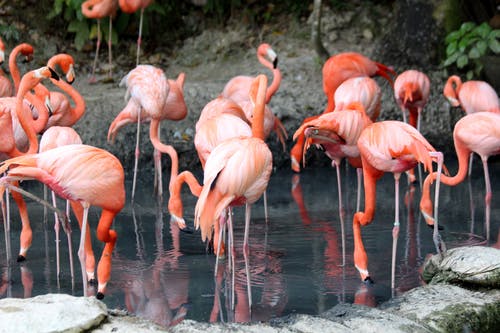Of the many species on earth, one of the most fascinating and beautiful ones is the pink flamingo. While not all humans might like to come into contact with such a large bird, the unique habits and looks of the flamingo have made them a point of interest in several aspects.
The pink color of this bird is one of its most defining traits, while its tendency to stand on one leg is another interesting habit. These birds have even made their way into everyday culture and the film industry, serving as certain symbols and even having their plastic versions banned in some states.
While these birds aren’t really in danger of extinction, they’re still worth knowing about if we want to understand our world in the best way possible. Let’s have a detailed discussion of them below:
About the Pink Flamingo
The Pink Flamingo, also known as the social bird, is one of the oldest species of birds with a history that dates back up to 50 million years. These birds with pink feathers, long necks, thin legs, and hooked bills can be seen from far away. Thousands of them can be found living together in a single colony, hence its reputation as being a social animal.
Pink Flamingos are generally found close to the sea, near large lakes and lagoons – think about the opening of Miami Vice. They usually don’t migrate, but if there is a change in the water level or climate, they will always migrate at night time in the form of their colony, all together.
The tallest flamingo has a height in between 3.9 feet to 4.7 feet and carries a weight of up to 7.7 lbs. The shortest, on the other hand, is approx. 2.6 feet tall and weighs up to 5.5. lbs.
From the Caribbean to Africa, South America, India, and the Mediterranean, there are six different species of flamingoes:
- Phoeniconaias minor or Lesser flamingo
- Phoenicoparrus andinus or Andean flamingo
- Phoenicoparrus jamesi or James’ flamingo or puna flamingo
- Phoenicopterus chilensis or Chilean flamingo
- Phoenicopterus roseus or Greater Flamingo
- Phoenicopterus ruber or American flamingo or Caribbean Flamingo
What They Eat
Flamingoes live on small insects, larva, mollusks, blue-green and red algae, crustaceans and small fish. They are omnivorous in nature and can eat both vegetables and meat.
The food of flamingoes also depends on its beak. Lesser, James and Andean Flamingoes have a deep-keeled bill and they live on algae. Greater, American and Chilean flamingoes have shallow-keeled bills and eat insects, small fish, and invertebrates.
The Reason Behind Their Pink Color
Some might wonder at the unique pink color of the flamingo, especially as most other birds don’t have such vivid coloring. The reason behind this coloring is the food that these birds eat.
Flamingoes usually eat algae, which contain beta-carotene, which is an organic chemical with a reddish-orange pigment. The same Beta-carotene is also present in mollusks and crustaceans, plants and vegetables such as tomatoes, spinach, sweet potato, and carrots.
Since this pink color is due to the Carotenoid present in their food, and food around them varies in quality as per the location, you will notice that flamingoes all around the world have different shades of pink. American Flamingoes have a bright red and orange color, while the lesser flamingoes have a pale pink shade to their body. The same effect is caused by brine shrimp, another staple of the flamingo’s diet.
This also means that if flamingoes don’t get food with carotenoids, the new feathers that grow will be pale in color and their signature pink feathers will lose their pink tone and soon shed away. When flamingos hatch out of their eggs, they’re actually a gray color, which is their true shade.
Location and Breeding
Flamingoes live in colonies or flocks; they protect each other, eat together, and also mate together. Being very faithful to their mating partner and monogamous in nature, a flamingo will stay with the partner it has mated with forever. It is also said that a group of flamingoes will mate together at the same time and their chicks all hatch at the same time too. The female partners lay one egg at a time while the male partner makes a nest of mud to keep the eggs protected.
Flamingo eggs are larger than chicken eggs. Contrary to some rumors, neither the eggs nor their yolks are pink in color!
An average egg takes 27-31 hours to hatch and weigh only around 2.5-3.2 ounces. Baby flamingos are born in white or grey color and turn pink as they grow. Some species might also sport a grayish-red coloring.
A flamingo baby is said to be mature in 3-5 years, while the average life of a wild flamingo is up to 20-30 years. However, flamingoes that live in the zoo are given special care and high-quality food, which can extend their life up to 50 years.
Flamingo Colonies
The colonies that flamingoes live in have several purposes, each of which benefits the birds in some manner. Living together like this helps the birds to ward off predators, for one. It also helps in maximizing their collection of food, and using nesting sites in the most efficient manner.
Before the breeding season comes around, each colony splits into separate breeding groups. These consist of several pairs of flamingos, ranging from 16 to 50 in each group.
The mating begins with some very synchronized displays, which includes stretching the neck upwards, calling to the mates, head-flagging, and several other actions. These displays seem to be somewhat random and help in matching up those who do not have a mate yet.
Once the baby is hatched from the eggs, it’s divided into groups or crèches after some time. If they do not join such a group, they’re vulnerable to predators.
Humans and Flamingos
Humans have a very unique relationship with flamingos, whether it’s the discussion on keeping statues of them as lawn ornaments or their place in popular culture. For instance, there are ceramic structures depicting flamingoes in Peru. It is also believed that the tongue of the flamingo was an Ancient Roman delicacy.
Ancient Peru also has some history of flamingo worship. The culture back then placed a lot of importance on animals in general, and flamingoes were of special interest to them. We can even see flamingoes featuring prominently in the artwork of that time.
Flamingoes are also the national bird in the Bahamas. There are certain urban legends about this bird, with some cultures believing that their fat cures tuberculosis.
Apart from this rich history, we also know that flamingoes have been around for quite some time due to there being 30 million-year-old fossils depicting this particular group. According to experts, this takes flamingoes back to a time when most aviary orders hadn’t evolved yet.
Interesting Fact
- Flamingoes are known to stand on one leg and can also sleep in this position without any discomfort. The precise reason behind this idiosyncrasy isn’t known, but there are some theories. One is that this is done to conserve body heat, but the phenomemon is the same in warmer climates. another theory states that this is done to save on muscular effort. Research shows that the flamingo actually has better balance on one leg than on two.
- Despite being tropical birds, flamingoes can easily live in cold habitats if they have sufficient water and food around.
- Nearly all the species of flamingoes look alike, and only trained personnel can distinguish between all six types.
- The largest flock was gathered in East Africa, with more than 1 million flamingoes living together
- The beaks of flamingoes are naturally designed to strain tiny creatures from mud and water, which they may then safely enjoy.
- Flamingoes eat with their head up-side-down. They stir mud with their feet and bend down to scoop mud and water with their beak. They might also splash the water using both their webbed feet in order to bring their prey nearer the surface.
- The rarest of all species is the American Flamingo, while the most common species are the Lesser Flamingo and Greater Flamingo.
- Not all the feathers of the flamingo are pink in color. In fact, some species have flight feathers that are black, but they can only be seen when the flamingoes are flying.
- Flamingoes mate together as if they are spinning and dancing.
- After the nest is built and the egg is laid, the male and female parents both take turns sitting on the egg.
- Mating pairs are extra careful about their nests, as these are often stolen by predators and others flamingoes.
Once the egg hatches, both parents feed the chick in turns with a special baby liquid called crop milk, which is produced in their throats. The production of this milk is stimulated by the hormone called prolactin, while the milk itself contains blood cells (both red and white), protein, and fat. This trait is similar to some other birds, such as doves and pigeons. However, flamingo crop milk usually has more protein and less fat in it.
The oldest known flamingo in the world was named Greater and had reached around 83 years of age. It was of the greater flamingo species and died on January 2014 at the Australian Adelaide Zoo.
Conclusion
The history, habits, and other traits of the flamingo certainly make it stand out from other bird groups. Fortunately, there are number of flamingos left on earth, so we don’t have to classify them as an endangered species just yet. Here’s hoping things remain this way!

